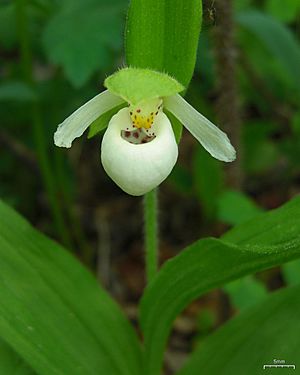Sparrow's-egg lady's-slipper facts for kids
Quick facts for kids Sparrow's-egg lady's-slipper |
|
|---|---|
 |
|
| Conservation status | |
| Scientific classification | |
| Genus: |
Cypripedium
|
| Species: |
passerinum
|
Cypripedium passerinum is a special type of lady's slipper orchid. People also call it the sparrow's-egg lady's-slipper, spotted lady's-slipper, or Franklin's lady's-slipper. This plant is known for its unique flower that looks a bit like a bird's egg.
Contents
What is the Sparrow's-Egg Lady's-Slipper?
This orchid is a rhizomatous plant. This means it grows from underground stems called rhizomes. It is a monocot, which is a type of flowering plant, and it lives for many years (it's a perennial herb). It can grow up to about 50 centimeters (20 inches) tall.
The plant has 3 to 7 leaves that are shaped like ovals or spears. These leaves grow one after another on the stem. Each leaf can be up to 19 centimeters (7.5 inches) long and 6 centimeters (2.4 inches) wide. The whole plant feels a bit hairy and sticky.
The Unique Flower
At the top of the stem, you'll find one or two flowers. Each flower has a top leaf-like part called a sepal that covers the petals. There are also two side sepals. The flower has three petals. Two of these petals are flat and white, growing on either side. The third petal is very special. It's shaped like a pouch and can be white or slightly pink. This pouch has purple spots on its edge and inside. People say these spots make it look like a sparrow's egg!
After the flower blooms, it produces a fruit that looks like a small capsule. This plant can grow new plants from its seeds. But it often grows new plants in another way. It sends up more stems directly from its underground rhizome. This is called vegetative reproduction.
Where Does This Orchid Live?
This type of Cypripedium orchid grows further north than most other kinds. You can find it in wet spruce forests where the land is not too high. It also grows in cold, treeless areas called tundra. Sometimes, it lives on dunes, along riverbanks, by lakeshores, and next to streams.
It often grows in soil that has a lot of calcium carbonate. This makes the soil a bit chalky.
Plant Neighbors
The sparrow's-egg lady's-slipper often shares its home with other plants. These include:
- White spruce (Picea glauca)
- Engelmann spruce (P. engelmannii)
- Western redcedar (Thuja occidentalis)
- Red-osier dogwood (Cornus sericea)
- Willows (Salix species)
- Horsetail (Equisetum species)
- Longtube twinflower (Linnaea borealis)
- Sedges (Carex species)
- One-sided pyrola (Orthilia secunda)
- Moss carpet (Pleurozium schreberi)
Where Can You Find the Sparrow's-Egg Lady's-Slipper?
Cypripedium passerinum is a native plant of northern North America. It is found across a large part of Canada. This includes areas from British Columbia all the way to Quebec. It also lives in Canada's three northern territories.
In the United States, you can find it in Alaska. It also grows in the Rocky Mountains of Montana. This includes places like Glacier National Park.
How This Orchid Helps the Ecosystem
We don't know a lot about how important C. passerinum is to its ecosystem. Some studies have shown that certain insects eat parts of these plants. These insects include moths, sawflies, and leaf miners.
Other types of Cypripedium orchids are pollinated by bees. But C. passerinum is different. It can pollinate itself. This means it does not need insects or other animals to help it reproduce. It can make seeds all on its own.
Many different plant species grow alongside the sparrow's-egg lady's-slipper. Some of these include Linnaea borealis, Carex concinna, Orthilia secunda, and Pleurozium schreberi.
Protecting the Sparrow's-Egg Lady's-Slipper
The Cypripedium passerinum is a very rare plant. It is at risk of disappearing forever. One reason it's so rare is that it needs very specific places to grow. If its habitat changes, it struggles to survive.
In the United States, this orchid is found in only two states: Alaska and Montana. The places where it grows in these states are sometimes threatened. For example, oil and gas exploration can harm its natural home. Protecting these special areas is very important to help this unique orchid survive.
See also
 In Spanish: Cypripedium passerinum para niños
In Spanish: Cypripedium passerinum para niños


